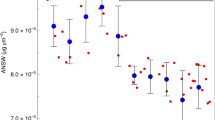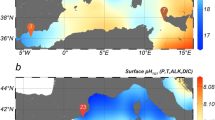Abstract
Increasing concentrations of carbon dioxide in sea water are driving a progressive acidification of the ocean1. Although the associated changes in the carbonate chemistry of surface and deep waters may adversely affect marine calcifying organisms2,3,4, current experiments do not always produce consistent results for a given species5. Ocean sediments record past biological responses to transient greenhouse warming and ocean acidification. During the Palaeocene–Eocene thermal maximum, for example, the biodiversity of benthic calcifying organisms decreased markedly6,7, whereas extinctions of surface dwellers were very limited8,9. Here we use the Earth system model GENIE-1 to simulate and compare directly past and present environmental changes in the marine realm. In our simulation of future ocean conditions, we find an undersaturation with respect to carbonate in the deep ocean that exceeds that experienced during the Palaeocene–Eocene thermal maximum and could endanger calcifying organisms. Furthermore, our simulations show higher rates of environmental change at the surface for the future than the Palaeocene–Eocene thermal maximum, which could potentially challenge the ability of plankton to adapt.
This is a preview of subscription content, access via your institution
Access options
Subscribe to this journal
Receive 12 print issues and online access
$259.00 per year
only $21.58 per issue
Buy this article
- Purchase on Springer Link
- Instant access to full article PDF
Prices may be subject to local taxes which are calculated during checkout



Similar content being viewed by others
References
Caldeira, K. & Wickett, M. E. Anthropogenic carbon and ocean pH. Nature 425, 365–368 (2003).
Langer, G. et al. Species-specific responses of calcifying algae to changing seawater carbonate chemistry. Geochem. Geophys. Geosyst. 7, Q09006 (2006).
Bijma, J., Spero, H. J. & Lea, D. W. in Use of Proxies in Paleoceanography: Examples from the South Atlantic (eds Fischer, G. & Wefer, G.) 489–512 (Springer, 1999).
Langdon, C. & Atkinson, M. J. Effect of elevated pCO2 on photosynthesis and calcification of corals and interactions with seasonal change in temperature/irradiance and nutrient enrichment. J. Geophys. Res. 110, C09S07 (2005).
Ridgwell, A. J. et al. From laboratory manipulations to Earth system models: Scaling calcification impacts of ocean acidification. Biogeosciences 6, 2611–2623 (2009).
Kennett, J. P. & Stott, L. D. Abrupt deep-sea warming, paleoceanographic changes and benthic extinctions at the end of the Paleocene. Nature 353, 225–229 (1991).
Thomas, E. in Geological Society of America Special Paper Vol. 424 (eds Monechi, S., Coccioni, R. & Rampino, M. R.) 1 (Geological Society of America, 2007).
Gibbs, S. J., Bown, P. R., Sessa, J. A., Bralower, T. J. & Wilson, P. A. Nannoplankton extinction and origination across the Paleocene–Eocene thermal maximum. Science 314, 1770–1773 (2006).
Kelly, D. C., Bralower, T. J., Zachos, J. C., Silva, I. P. & Thomas, E. Rapid diversification of planktonic foraminifera in the tropical Pacific (ODP Site 865) during the late Paleocene thermal maximum. Geology 24, 423–426 (1996).
Ridgwell, A. Changes in the mode of carbonate deposition: Implications for Phanerozoic ocean chemistry. Mar. Geol. 217, 339–357 (2005).
Zachos, J. C. et al. Rapid acidification of the ocean during the Paleocene–Eocene thermal maximum. Science 308, 1611–1615 (2005).
Goodwin, P., Williams, R. G., Ridgwell, A. & Follows, M. J. Climate sensitivity to the carbon cycle modulated by past and future changes in ocean chemistry. Nature Geosci. 2, 145–150 (2009).
Panchuk, K., Ridgwell, A. & Kump, L. R. Sedimentary response to Paleocene Eocene thermal maximum carbon release: A model-data comparison. Geology 36, 315–318 (2008).
Nakicenovic, N. & Stewart, R. (eds) Emissions Scenarios: Special Report of the Intergovernmental Panel on Climate Change (Cambridge Univ. Press, 2000).
Zeebe, R. E., Zachos, J. C. & Dickens, G. R. Carbon dioxide forcing alone insufficient to explain Palaeocene–Eocene thermal maximum warming. Nature Geosci. 2, 576–580 (2009).
Archer, D. et al. Atmospheric lifetime of fossil-fuel carbon dioxide. Annu. Rev. Earth Planet. Sci. 37, 117–134 (2009).
Davis, M. B., Shaw, R. G. & Etterson, J. R. Evolutionary responses to changing climate. Ecology 86, 1704–1714 (2005).
Santiago, F. E. & Sanjuan, R. Climb every mountain? Science 302, 2074–2075 (2003).
Buckling, A., Wills, M. A. & Colegrave, N. Adaptation limits diversification of experimental bacterial populations. Science 302, 2107–2109 (2003).
Meissner, K. J., Eby, M., Weaver, A. J. & Saenko, O. A. CO2 threshold for millennial-scale oscillations in the climate system: Implications for global warming scenarios. Clim. Dyn. 30, 161–174 (2008).
Shaffer, G., Olsen, S. M. & Pedersen, J. O. P. Long-term ocean oxygen depletion in response to carbon dioxide emissions from fossil fuels. Nature Geosci. 2, 105–109 (2009).
Hofmann, M. & Schellnhuber, H.-J. Oceanic acidification affects marine carbon pump and triggers extended marine oxygen holes. Proc. Natl Acad. Sci. USA 106, 3017–3022 (2009).
Ridgwell, A. et al. Marine geochemical data assimilation in an efficient Earth system model of global biogeochemical cycling. Biogeosciences 4, 87–104 (2007).
Ridgwell, A. J. & Hargreaves, J. C. Regulation of atmospheric CO2 by deep-sea sediments in an Earth system model. Glob. Biogeochem. Cycles 21, GB2008 (2007).
Cao, L. et al. The role of ocean transport in the uptake of anthropogenic CO2 . Biogeosciences 6, 375–390 (2009).
Tindall, J. C. et al. Modeling the oxygen isotope distribution of ancient seawater using a coupled ocean-atmosphere GCM: Implications for reconstructing early Eocene climate. Earth Planet. Sci. Lett. (in the press).
Martin, R. E. Cyclic and secular variation in microfossil biomineralization—clues to the biogeochemical evolution of Phanerozoic oceans. Glob. Planet. Change 11, 1–23 (1995).
Tyrrell, T. & Zeebe, R. E. History of carbonate ion concentration over the last 100 million years. Geochim. Cosmochim. Acta 68, 3521–3530 (2004).
Acknowledgements
A.R. and D.N.S. acknowledge support from The Royal Society in the form of University Research Fellowships, the UK National Environmental Council grants NE/F001622/1 and NE/F002408/1, together with NSF EAR-0628719. This work arose out of the IGBP-SCOR Fast Track Initiative on Ocean Acidification and is a contribution to the EU EPOCA ocean acidification initiative.
Author information
Authors and Affiliations
Contributions
A.R. conceived and analysed the model experiments. Both authors discussed the results and wrote the paper.
Corresponding author
Ethics declarations
Competing interests
The authors declare no competing financial interests.
Supplementary information
Supplementary Information
Supplementary Information (PDF 695 kb)
Rights and permissions
About this article
Cite this article
Ridgwell, A., Schmidt, D. Past constraints on the vulnerability of marine calcifiers to massive carbon dioxide release. Nature Geosci 3, 196–200 (2010). https://doi.org/10.1038/ngeo755
Received:
Accepted:
Published:
Issue Date:
DOI: https://doi.org/10.1038/ngeo755
This article is cited by
-
Multi-proxy evidence for sea level fall at the onset of the Eocene-Oligocene transition
Nature Communications (2023)
-
Increased ocean acidification by upwelling intensification in southern Tethyan margin during the PETM: implication for foraminiferal record
Carbonates and Evaporites (2022)
-
The formation of authigenic deposits during Paleogene warm climatic intervals: a review
Journal of Palaeogeography (2020)
-
Loss of fixed nitrogen causes net oxygen gain in a warmer future ocean
Nature Communications (2019)
-
New constraints on the last aragonite–calcite sea transition from early Jurassic ooids
Facies (2018)



